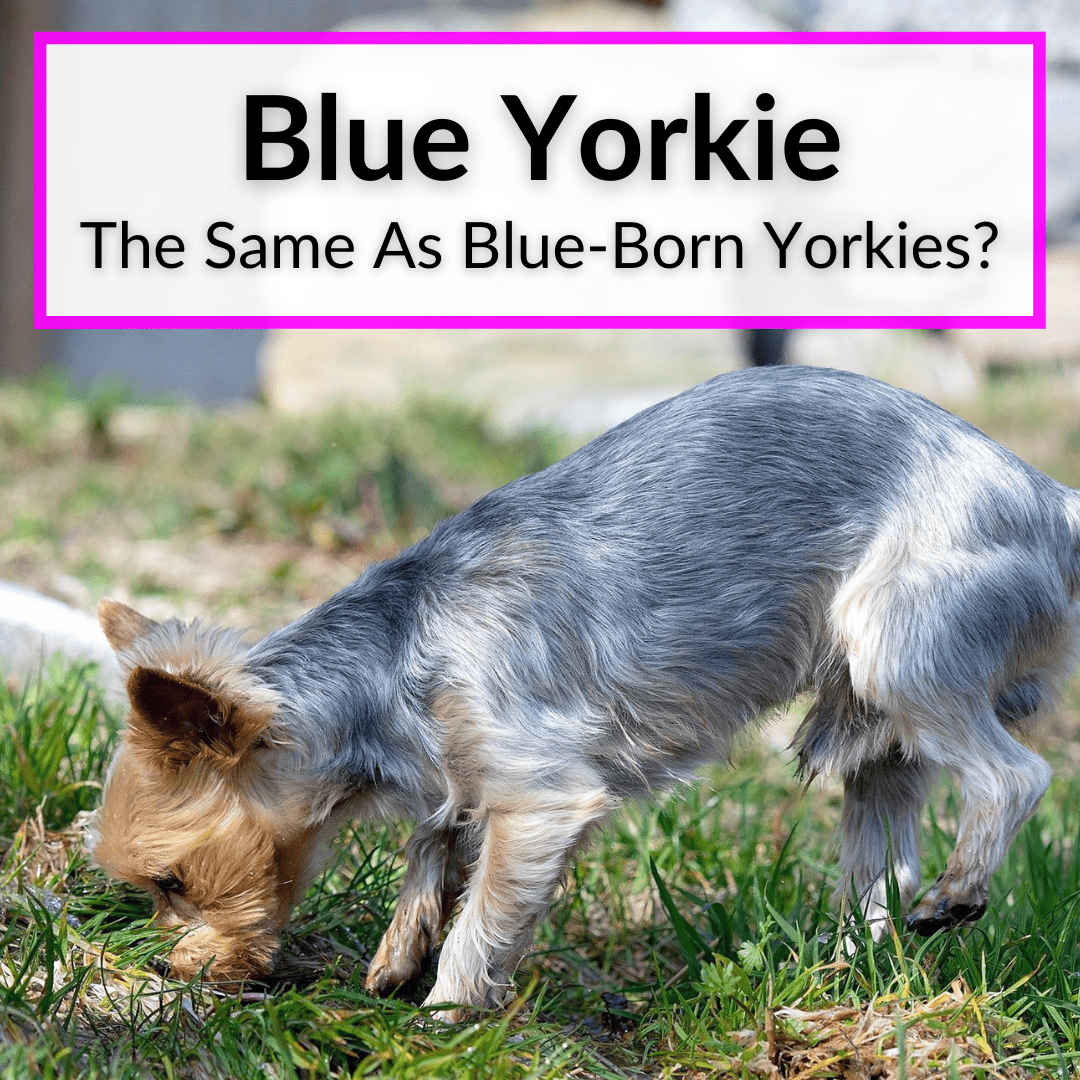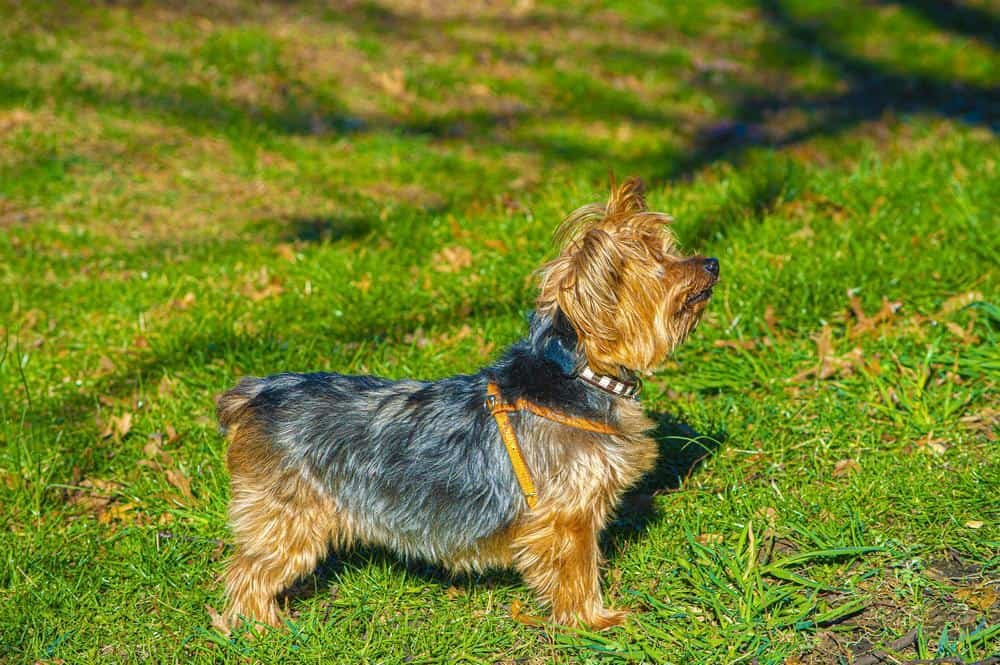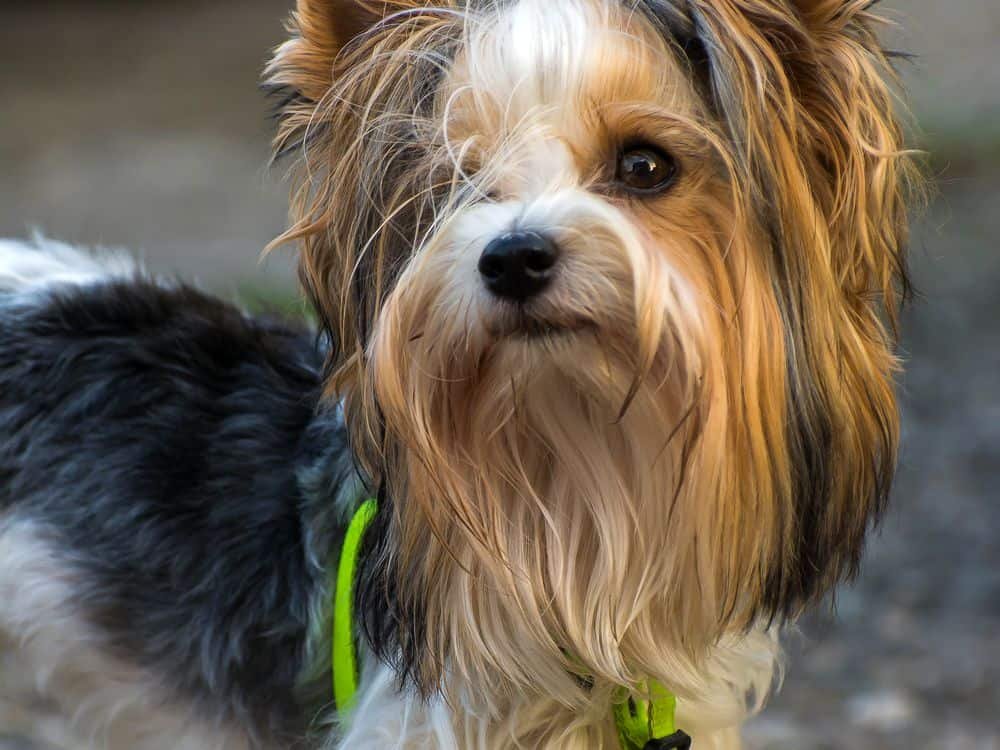
I’m sure you’ve realized that, if you’ve been searching for information on Google.
There are only a few articles out there and they do a pretty horrible job at explaining things. Some of them are quite confusing.
That’s mainly because they got their information from the other articles that are on Google and they weren’t quite able to make sense of it.
That ends now.
What confused so many of these websites is that a blue yorkie can actually refer to two different things.
We’ll cover them both below.
Keep reading to learn everything you need to know about blue Yorkshire terriers. We’ll help you finally make some sense of it all.
Contents
Blue Yorkies
The Yorkshire terrier is one of the most recognizable breeds there is. And their most recognizable feature is their silky coat.
Yorkie hair is unique in that it resembles human hair more than the usual dog fur. And officially, at least, it only comes in four different colors. One of those colors is blue.
It’s not the kind of blue you’re thinking. It’s not a bright blue, but a steel blue. It is closer to a gray or a silver.

Since this is one of the official yorkie colors, a blue yorkie is really just a yorkie. Almost all of them end up having this steel blue fur, in combination with gold, once they have matured.
But there is also another type of blue Yorkshire terrier. This one is more accurately called a blue-born yorkie. As the name suggests, this type of Yorkshire terrier is born blue.
And we’re not talking the standard steel-blue either. It is a much brighter blue. I wish I could show you a photo, but I was unable to find one. Not surprising, considering how rare these blue yorkie puppies are.
And before you think having a blue yorkie puppy would be cool, you should know things never end well for these unfortunate pups. Very few survive and the ones who do almost always have a miserable life full of pain and suffering.
Let’s take a closer look at these blue-born yorkshire terriers, before going into more detail on the standard yorkie and its blue fur.
Blue-Born Yorkies

As mentioned, purebred yorkies have blue fur. But it is not a bright blue, but more of a silverish-blue or a blue-gray. And they are not born with this color.
At birth, most yorkies are usually black and tan. This color scheme can vary a bit from dog to dog. Some have more black than tan, while others are the opposite.
Yorkies are are never born with just only one color. Even if one appears completely black when born, you can find some tan in there, if you look closely.
As the dog matures, this black and tan fur slowly changes to the aforementioned blue and gold. These are the normal blue yorkies.
Blue-born yorkies are born with blue fur. A real blue, not the gray-blue that is standard in the breed. And other parts of their bodies are blue as well, like the nose.
This is an extremely rare condition that is the result of a deeply recessive gene that is handed down by both parents. It is a terrible affliction for any affected puppy.
Most of them die within a few days. Those that do not are unlikely to have a pleasant life. It is possible for them to live a normal life, but it is exceedingly rare.
The majority that survive the first few days end up changing around the same time a regular Yorkie changes color. But instead of getting a new color, they tend to lose their coat entirely and get an extremely leathery skin, similar to an elephant hide.
This causes the affected dog incredible pain. For that reason, breeders usually put down blue-born Yorkshire terriers, to save them from the misery to come. At the latest, they need to be put down once their skin becomes leathery.
The lucky few that do not survive the early days and do not suffer the skin change, may live mostly normal lives. But they are more prone to various health issues and are likely to be plagued by problems and pain their whole lives.
As you can see, blue-born yorkies are not something to be celebrated. It is a tragedy for the poor dg affected by this issue. The good news is that it is incredibly rare.
That is why the term blue yorkie is probably more commonly used to simply refer to a standard yorkie who has a coat that is perhaps a bit more blue than it is silver or gray. So let’s take a look at the standard yorkie colors now.
Standard Blue Yorkshire Terrier

What colors do Yorkies come in? The American Kennel Club only recognizes four official colors for the yorkie breed: black, blue, tan, and gold. As mentioned, puppies tend to be black and tan, while adults are blue and gold.
But this is not always the case and as long as some combination of these four colors is present, the dog can be considered a purebred yorkie. And there is one more option.
The parti yorkie has three colors, with white joining the mix. Some parti yorkies can even be mostly white. The AKC recognizes parti yorkies as purebred, but a nonstandard variety.
Let’s take a closer look at the various possible color combinations for purebred Yorkshire terriers.
Color Combinations
According to American Kennel Club purebred yorkies can only have the combinations of black and tan, black and gold, blue and tan, and blue and gold. However, some they do also recognize some nonstandard colors.
Black And Tan
This is the breed standard for purebred puppies. The tan can veer more toward brown, but this is by far the most common combination you will see. The location and proportion of each color varies from dog to dog.
Most commonly, a puppy will have a predominantly black coat, with some tan points around the tops and undersides of the ears. You can also see some above the eyes, around the mouth area, down the chest, and sometimes on the feet and tail.

Black And Gold
As mentioned, the shade, location and proportion of the colors can vary from one puppy to the next. This is also true of the rate at which the colors change as the dog matures.
As a result, it is quite possible to have a gold and black yorkie. This happens when the lighter phaeomelanin progresses at a fast rate than the dark eumelanin. In other words, the tan portions turn to gold faster than the black ones turn to blue.
Blue And Gold
Just as black and tan is the standard combination for puppies, blue and gold is the standard for adults. Most puppies begin changing colors around six months of age. It is a gradual change that can take up to the age of three before it is complete.
However, most dogs have their adult coloring by the time the reach the age of two.
When they hair begins to change color, the black portions lighten into the steel blue color, while the tan portions lighten to become gold. So you could also describe this color change as a simple lightening of their coat. Usually, the hair is darker at the roots than at the tips.
Blue And Tan Yorkie
Just as you can have a black and gold yorkie puppy, you can also have a blue and tan adult yorkie. It results from the phaeomelanin in the genes expressing as a darker hue.
Be mindful that this can be somewhat subjective. What one person sees as tan, another might see as gold. But it is certainly the case than some dogs look much more tan than gold and the blue and tan combination is listed as an official combination in the Yorkshire terrier category in the AKC’s registry.
Nonstandard Colors

The four color combinations we just saw are historically the official colors of this breed. However, the AKC now officially recognizes the parti yorkie and its nonstandard Parti Yorkie colors as a purebred yorkie, albeit a nonstandard variety.
Parti yorkies have three colors in their coats, with white showing up in a major way. Most are some combination of white, tan and black.
Any other colors that you might find in yorkies are not officially recognized and are thus the result of crossbreeding. As such, they can never be considered purebred.
Why Yorkies Change Colors
Yorkshire terrier genetics are complicated, but we’ll try to simplify things a bit. Here is how it works, in a nutshell.
Every cell in your dog’s body contains at least 39 pairs of chromosomes. These are inherited from the parent dogs.
Every one of these chromosomes contains thousands of genes, and carries all the information that makes your puppy unique. This includes its sex, size, color, personality, and many other physical traits.
Some genes are dominant and some are recessive. When one parent passes on a dominant gene and the other passes on a recessive gene, the dominant gene is the one that manifests in the puppy.
If both genes are dominant or recessive, you can get rare and unexpected results. This is the most common reason why every yorkie looks and acts somewhat differently from other yorkies. Just like us humans.
For many puppies, the black, sable eumelanin found in yorkies dominates. But as the puppy ages, its genetic makeup instructs some of the eumelanin to lighten up. This changes the black to a lighter color: the silver-blue for which adult yorkies are famous..
The change of colors is always dependent on the genes a puppy inherits from its parents. The genes can determine whether the puppy will be light or dark, and where the different colors will manifest.
Blue Yorkie: Final Thoughts
Blue yorkie can mean two different things. It can be a blue-born yorkie, which is a puppy born entirely blue. This is a genetic defect that usually results in an early death, or a life full of pain.
But the term ‘blue Yorkshire terrier’ can also simply refer to the standard yorkie blue color, which is more of a silver blue. The combination of this blue with gold is the most common color combination in adult yorkies.
Susan Shaw says
I have a blue born Yorkie born in 2013. She was delivered c-section. There were 2 boy born blue puppies as well, the vet that delivered them said. “You have rare colored Yorkie puppies! I’m sure you can get a high price for them!” I began researching this and found pretty much what you have described in your article, within a few days, or maybe a week, the 2 boys passed away. But! The girl continued to thrive! As you described above, she began to lose her hair, mostly on the body, she has a full head and neck of hair, some along her sides and on her hind end. I kept telling myself she wouldn’t live long, but she is now 9 years old and very healthy. She actually came from a backyard breeder I was working with to improve the conditions of the dogs. So I shared what I learned about this with her and encouraged her to get the stud fixed. She waited until another of her females had a litter with more blue born puppies. Again all the boys died within days. There was 1 girl which has survived like the one I have. At that point the breeder agreed to let me take he stud, get him fixed and then rehome him. If you contact me I would be glad to send you some pictures of Hershey Kiss!
Mike Kelsen says
I just added one of the photos you sent of little supermodel Hershey Kiss. Thank you so much for sharing!
Lori Peer says
I think my Shaggy might be in the same boat as your Hershey Kiss. He has almost no fur on his body but has a mane around his face, legs and hind end. He doesn’t appear to be in any pain, seems to be very healthy. How would I know if he is in pain? What symptoms should I look for?
James says
James I have a blue yorkie now male he lived he is 11weeks
Amy Knuth says
I have a blue born, Pistol. He is now 5 years old. I would love to share pictures.
Mike Kelsen says
I’d love to see some! And if it’s cool with you, I could even add one or two to the article, if they’re decent quality. You can send them to mkelsen@yyorkie.com
Gary Spivack says
Hi: Love your blog-very informative. I was surprised that you didn’t mention red-legged Yorkies. These are wonderful dogs that do not loose their black coloring as they mature and develop a deep red color on the legs, cheat and ears. It is a dazzling color in the proper light. Our little boy, Rufus passed last year and he was a beautiful red-legged Yorkie. GS
Mike Kelsen says
Red-legged Yorkies are included in our post on different Yorkie colors: http://yyorkie.com/what-colors-do-yorkies-come-in/